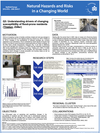PhD-Project Q3 by Jonas Laudan (UP):
Understanding drivers of changing susceptibility of flood-prone residents
Timescale: Oct. 2015 – Aug. 2019
Supervisors:
Prof. Dr. Annegret Thieken, University of Potsdam
PD Dr. Gert Zöller, University of Potsdam
Background
Floods are responsible for the largest economic losses worldwide. In the future, climate change may contribute to an increase in flood losses in several regions due to increasing flood frequencies and magnitudes. However, ongoing settlement and economic development have already led to continuously rising assets in flood-prone areas. Human-induced changes in land use have been identified to play a key role in flood risk development.
While an increasing number of studies combines climate and land use change to assess future flood risks on the regional scale, changes in the susceptibility of exposed buildings are currently neglected in loss estimations. In most of the studies, simple loss models, such as stage-damage curves for standard buildings, were used. This is contrasted by recent reports of insurers that floods or hail storms cause tremendous losses particularly at modern buildings with a good thermal insulation and innovative building materials. While these buildings perfectly fulfil the requirements of energy saving standards that are important to mitigate climate change in the long run, it seems that such constructions tend to drive average building losses due to their high susceptibility to flooding and other impacts of natural events. On the contrary, private precautionary measures are able to reduce flood damage to great extent and are frequently implemented after having experienced a flood (e.g., Thieken et al., 2007). Therefore, this project focused on the development of average building losses in the view of a combined mitigation of climate change and natural hazard risks.
Objectives and Methods
The PhD-project aimed at explaining and quantifying changes in the susceptibility of residents and their homes to flooding due to their precautionary and preparatory behaviour. The ultimate goal was to develop more reliable flood loss estimation models that account for private mitigation measures and hence can be used to assess future flood risks and risk reduction through non-structural adaptation.
We analysed whether there is empirical evidence for recent changes in building susceptibility to floods, and identify and characterise highly susceptible buildings; statistical analyses have been complemented by using data mining techniques. This was based on large data sets from computer-aided telephone interviews with private households in Germany that were affected by flooding between 2002 and 2013. Besides describing building and content losses, these data contain a wealth of information on e.g. hydraulic impacts, construction types, precautionary measures, socio-demographic data. In a second step, we identified key factors that govern homeowners’ decisions on climate and/or flood-proof building constructions and precautionary behaviour. To test their influence on mitigation behaviour, households that were affected by the flood in 2013 and have already been interviewed in spring 2014 and autumn 2014 and ideally every two years thereafter to monitor risk perception and behaviour. The questionnaire included questions on homeowners’ perceptions of climate change, natural hazards and living standard. Data analysis greatly benefited from Bayesian analyses (Zöller et al., 2013).
Publications within NatRiskChange:
Bubeck, P., Botzen, W. J. W., Laudan, J., Aerts, J. C. J. H., and Thieken, A. H. (2017): Insights into Flood-Coping Appraisals of Protection Motivation Theory: Empirical Evidence from Germany and France, Risk Analysis, 38(6): 1239-1257, https://doi.org/10.1111/risa.12938.
Laudan, J., Rözer, V., Sieg, T., Vogel, K., and Thieken, A. H. (2017): Damage assessment in Braunsbach 2016: Data collection and analysis for an improved understanding of damaging processes during flash floods, Nat. Hazards Earth Syst. Sci. 17, 2163–2179, 2017, https://doi.org/10.5194/nhess-2016-387.
Laudan, J., Zöller, G., and Thieken, A. H.: Flash floods versus river floods – a comparison of psychological impacts and implications for precautionary behaviour. Natural Hazards and Earth System Sciences (in review), www.nat-hazards-earth-syst-sci-discuss.net/nhess-2018-407/
Vogel, K., Ozturk, U., Riemer, A., Laudan, J., Sieg, T., Wendi, D., Agarwal, A., Rözer, V., Korup, O., and Thieken, A. H. (2017): Die Sturzflut von Braunsbach am 29. Mai 2016 – Entstehung, Ablauf und Schäden eines „Jahrhundertereignisses“. Teil 2: Geomorphologische Prozesse und Schadensanalyse. The Braunsbach Flashflood of Mai 29th, 2016 – Origin, Pathways and Impacts of an Extreme Hydro ‐ Meteorological Event. Part 2: Geomorphological Processes and Damage Analysis. ‐ Hydrologie und Wasserbewirtschaftung, 61 , 3, pp. 163—175
Thesis to download:

